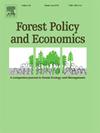Sustainable forestry logistics: Using modified A-star algorithm for efficient timber transportation route optimization
IF 4
2区 农林科学
Q1 ECONOMICS
引用次数: 0
Abstract
The use of brown, recyclable wood resources has significant importance in a country like Canada, given their abundant availability. Nevertheless, the conveyance of these timber resources to wood recycling facilities offers many economic and environmental benefits to pertinent entities. One potential drawback is that the forest ecosystem could endure substantial harm and ultimately disappear if every road were utilized as access points for timber-transporting vehicles. The main aim of this project is to collect the maximum amount of recycled wood using a minimum forest road network to achieve smart logistics systems. An additional objective of this research is to ascertain the optimal search radius and blocks of area for conducting woodland searches at each station, taking into consideration the quantity of collected wood. The methodology employed in this study involves the application of geometric networking integration techniques in Geographic Information Systems to generate integrated maps using the forest route data, and a modified A-Star algorithm is utilized to efficiently determine the optimal wood recycling forest road. The study's results suggest that using the Modified A-Star algorithm enables a recycling rate between 50 % and 70 % for the collection of all wood items while utilizing just 10 % of the road network. This approach and technique might be used in future research conducted in countries with similar forest coverage levels.
可持续林业物流:基于改进a星算法的高效木材运输路径优化
在加拿大这样的国家,使用棕色、可回收的木材资源具有重要意义,因为它们的可用性非常丰富。然而,将这些木材资源运送到木材回收设施为有关实体提供了许多经济和环境利益。一个潜在的缺点是,如果每条道路都被用作木材运输车辆的入口,森林生态系统可能遭受重大损害,并最终消失。该项目的主要目的是利用最小的森林道路网络收集最多的再生木材,以实现智能物流系统。本研究的另一个目标是考虑到收集的木材数量,确定在每个站点进行林地搜索的最佳搜索半径和区域。本研究采用地理信息系统中的几何网络集成技术,利用森林路径数据生成综合地图,并利用改进的a - star算法有效确定最优木材回收森林路径。研究结果表明,使用改进的a - star算法,所有木材的回收利用率在50%到70%之间,而只利用了10%的道路网络。这种方法和技术可用于今后在森林覆盖率相似的国家进行的研究。
本文章由计算机程序翻译,如有差异,请以英文原文为准。
求助全文
约1分钟内获得全文
求助全文
来源期刊

Forest Policy and Economics
农林科学-林学
CiteScore
9.00
自引率
7.50%
发文量
148
审稿时长
21.9 weeks
期刊介绍:
Forest Policy and Economics is a leading scientific journal that publishes peer-reviewed policy and economics research relating to forests, forested landscapes, forest-related industries, and other forest-relevant land uses. It also welcomes contributions from other social sciences and humanities perspectives that make clear theoretical, conceptual and methodological contributions to the existing state-of-the-art literature on forests and related land use systems. These disciplines include, but are not limited to, sociology, anthropology, human geography, history, jurisprudence, planning, development studies, and psychology research on forests. Forest Policy and Economics is global in scope and publishes multiple article types of high scientific standard. Acceptance for publication is subject to a double-blind peer-review process.
 求助内容:
求助内容: 应助结果提醒方式:
应助结果提醒方式:


